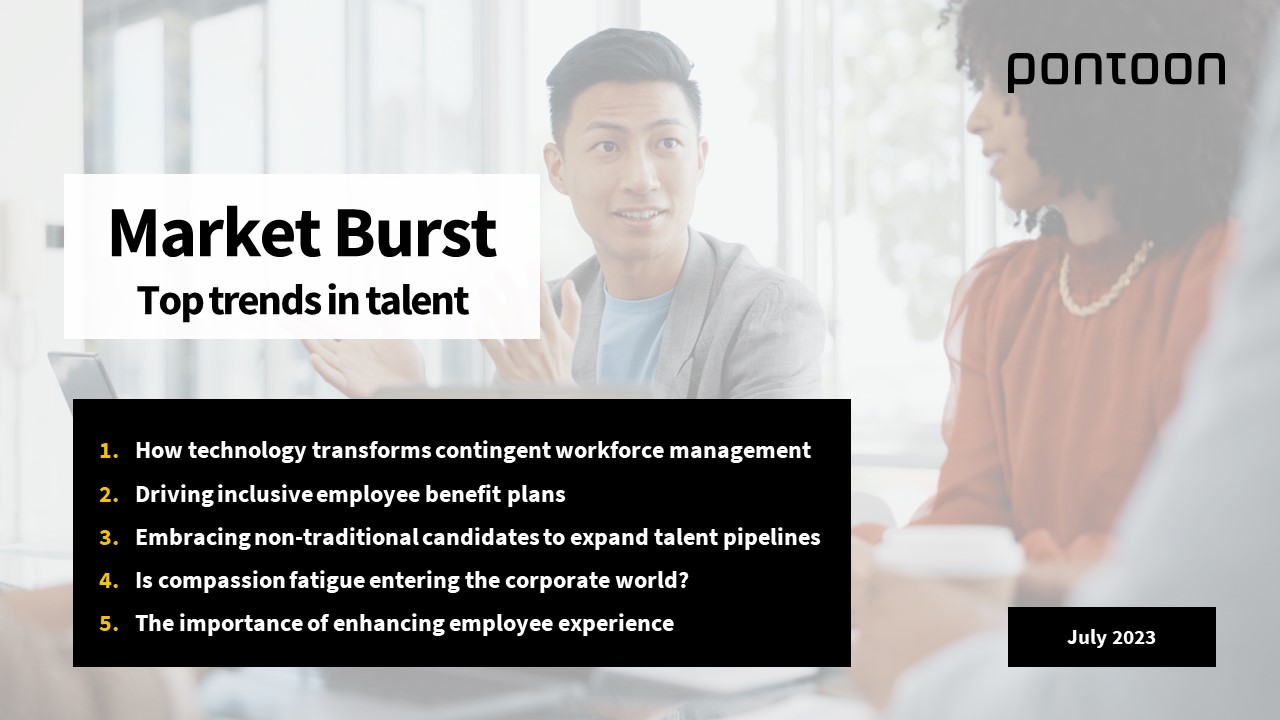Market Burst: July 2023
Read about top trends in the world of work.
In this month’s instalment of our Market Burst, we dive into the trends that continue to drive talent management in the evolving workspace. These include technology transforming contingent workforce management, embracing non-traditional candidates, enhancing the employee experience, and more.
How technology transforms contingent workforce management
The effective management of a non-employee workforce relies heavily on technology for maximised productivity, reduced compliance risks, and streamlined operations. More than 80% of firms surveyed by Everest said that simpler and faster process management is their primary benefit of implementing a VMS. The automation offered by the VMS platforms, nowadays often coupled with AI enhancements, can reduce work hours in the entire contingent labour management cycle by 10 – 35%. With other benefits including shorter time-to-hire, improved efficiencies, and better supply chain management, it’s not surprising that adoption of VMS in mid-market firms grew by 20% globally between 2019 and 2021.
At Pontoon, we fully understand technology’s significant role in enhancing our clients’ services. As part of our advisory function – Pontoon Instinct – and specifically within the Technology & Integration practise – we help customers scope, build and deploy technology solutions that best suit their business requirements. This includes supporting VMS selection, implementation, and adoption. Our latest whitepaper explores more areas where VMS platforms deliver significant value, such as instant visibility into vital data, conformity to local regulatory requirements, cost transparency, and more.
Technology solutions have emerged as critical allies in a business world of constant disruptions. Adopting VMS tech allows companies to stay agile and adapt to shifting workforce requirements. The market is profoundly transforming, and VMS technology providers are evolving to offer strategic support in managing organisations’ total talent needs.
“Deploying a VMS allows for a centralised system that provides visibility not only into where your global contingent workforce sits but, when coupled with other leading technology, it also ensures quick access to pertinent data to shape your future talent strategies.”
Abdul Layne, Head of Technology & Integration, Pontoon Instinct
Driving inclusive employee benefit plans
As the workforce becomes increasingly diverse, the needs of employees constantly evolve. This forces companies to understand what their people value and how to keep benefit packages attractive and inclusive.
One thing to watch out for when creating benefit policies is to ensure LGBTQ+ individuals are not excluded from health care and family-building coverage. For example, when offering fertility benefits, making these available to all employees is crucial, as supporting surrogacy or IVF costs can also help LGBTQ+ workers looking to start families. The next step includes extending traditional medical coverage with hormone replacement therapies, reconstructive surgical procedures, and supportive mental health care. For instance, in 2022 Virgin Media O2 introduced a new DE&I strategy that includes gender transition support package for their transgender and non-binary employees.
Neonatal leave schemes are an interesting development in the area of inclusive benefits. These were designed to assist workers who experience premature births or whose babies require special medical care. The UK is leading the way, especially after Neonatal Care Act was passed in May 2023, but in Croatia, Finland, and Canada, maternity leave can also be extended in case of preterm deliveries.
Research shows that in the UK alone, for 70% of families with babies in neonatal care, one parent must return to work, forcing many to take unpaid holidays or leave the workforce permanently. Almost 5 in 10 UK firms don’t offer neonatal leave policies yet, but there are some notable exceptions. For example, in October 2022, an international investment company M&G introduced a neonatal leave policy. It states that for every seven days an employee’s baby spends in hospital, the parent can take one week of paid leave.
Embracing non-traditional candidates to expand talent pipelines
According to Gartner, organisations who succeed at recruiting and retaining outside-the-box candidates will have a significant leg up in the current competitive labour market. Non-traditional talent can include individuals without formal education or experience, people from diverse backgrounds, or workers reskilled from different industries.
Another interesting angle is the growing importance of engaging contingent workforce, including freelancers, contractors, and gig workers. SIA estimates that the global gig economy was worth $5.4 trillion in 2021, with independent contractors responsible for $3 trillion or 56% of the total. European countries that engage the biggest number of non-FTE workers include Italy, Poland, the UK, and the Netherlands.
In today’s rapidly changing business landscape, contingent workforce solutions play an increasingly vital role in enabling organisations to remain agile and responsive to market demands. Freelancers, contractors, and gig workers offer unique advantages, such as specialised skills, reduced overheads, and the ability to scale operations quickly.
The key components of embracing contingent workforce include:
- Adopting a comprehensive workforce strategy that encompasses all types of workers.
- Establishing robust systems for managing, engaging, and integrating contingent workers into the company culture.
- Implementing effective communication channels, performance management processes, and a consistent onboarding experience.
Is compassion fatigue entering the corporate world?
Compassion fatigue shares many symptoms with burnout, including apathy, exhaustion, and a lack of interest in one’s work. Caregivers, first responders, social workers, and teachers experience compassion fatigue after years of supporting others. Some recent sources claim that after the pandemic, corporate workers also share a similar lack of emotional bandwidth to care for colleagues, clients, bosses, and family, which results in irritability and frustration. However, considering that compassion fatigue stems from prolonged exposure to human suffering and caring for other people’s needs, it’s debatable whether the exact same phenomenon is prevalent in the corporate world.
Undoubtedly, workers across global firms experience a heightened level of burnout that comes from emotionally exhausting interactions with clients and colleagues that lead to impatience and annoyance. The situation is even more dire among the frontline workers who claim that they experience negative behaviour from customers more often compared to five years ago. Considering that nearly 8 in 10 face incivility at work at least once a month, and 70% witness it at least two to three times a month, employers must take this issue seriously. Just as workers who interact with upset clients can experience burnout, so can managers who deal with distressed team members.
With an increased focus on employee well-being, companies should build workplaces where compassion and the right to rest can thrive. Overcoming burnout involves creating work boundaries for employees. Firms should encourage their teams to disconnect from work, take days off for mental health, and prioritise rest. This can help individuals regain emotional well-being and passion for their work, ultimately driving talent retention.
The importance of enhancing employee experience
Experience design focuses on creating a workplace environment that helps foster a sense of belonging, motivation, and commitment to the organisation. Enhancing employee experience is among Gartner’s top five 2023 HR priorities. One crucial improvement area is creating better internal career trajectories. While workers leave their companies for better development opportunities at similar rates as they do for higher compensation, 4 in 10 HR leaders admit that their organisation doesn’t have compelling career paths to keep people retained longer.
What can employers do to ensure their value proposition matches the expectations and aspirations of their people? Our Workforce Strategy whitepaper provides more insight into strategies that include:
- Engaging workers in identifying areas for improvement and designing solutions, as they are the ones who have first-hand knowledge of the challenges experienced every day.
- Encouraging workers to experiment and take risks – they should be empowered to participate in projects from different business areas, learn from mistakes, and continuously refine development goals.
- Aiding workers in realising how their individual career paths align with overall business goals to foster a sense of purpose among the workforce.
By integrating experience design into their workforce strategy, organisations can create an environment that supports flexibility, resilience, and retention.
Related Post
Read about top trends in the world of work.
In this month’s instalment of our Market Burst, we analyse the trends that continue to drive talent management in the evolving workspace. ...





